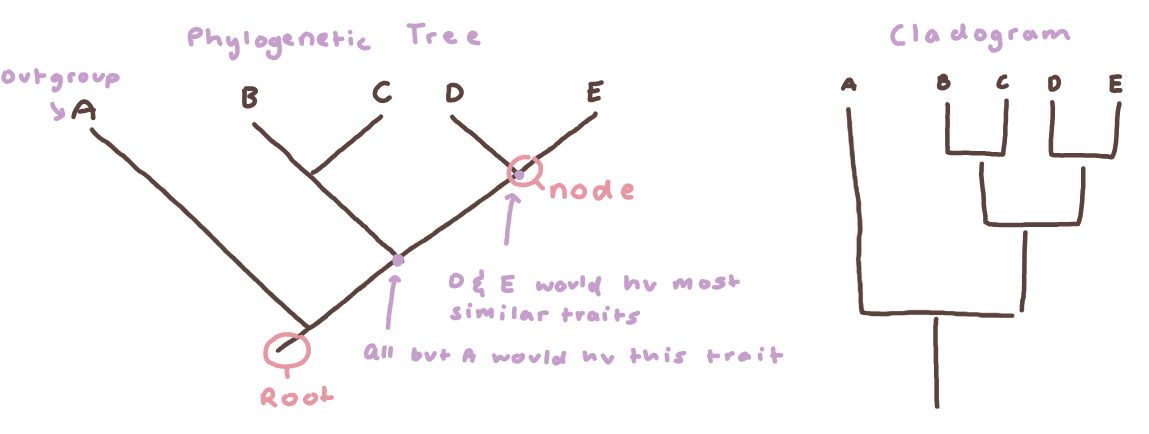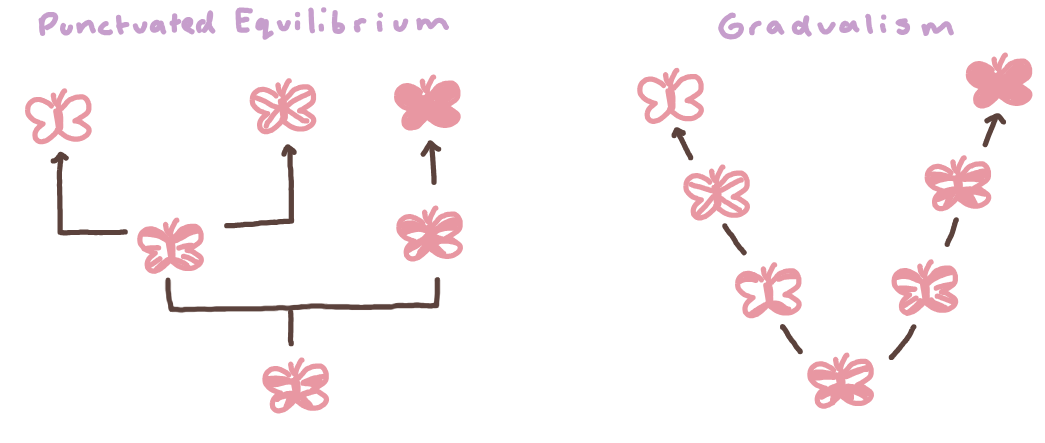ap bio : unit 7 cram sheet (copy)
Author’s Notes
hello there, and welcome to my unit 7 cram sheet on natural selection !! majority of the info is gathered from my teacher lectures and the AP daily videos :)
like this cram sheet? I made more ! check it out at my profile ;))
external links to other resources will also be linked to help you better understand this topic !!!!
╭ Other Resources :
:: TBA - mcq progress check﹒﹒already took the mcq? “take it again” in flashcard form with an additional explanation of the answer! (frm urs truly :D )
:: cararra ﹒﹒ 34 min ap bio review video based from the campbell biology 11th edition textbook!
:: khan academy ﹒﹒the entire unit 7 course from khan academy!!
:: fiveable ﹒﹒ reviews unit 7 with articles and quizzes for you to practice your knowledge on!
﹙✦﹚﹒﹒please note that abbreviations will be used throughout this guide (kept at a minimum!)
﹙7.1-7.3, 7.12 - Natural Selection & Diversity﹚
✦﹒natural selection is the process by which organisms, having adaptations suited for a particular environment, have a greater chance of survival and reproduction, thereby passing the adaptations to subsequent generations
evolution is the change in genetic makeup of a population over time and is supported by multiple lines of evidence
natural selection is a major mechanism of evolution
driven by random occurrences, cannot continue without genetic variation
influenced by the following—
environmental stability of biotic and abiotic environments
environments can experience major disruptions and change quickly/slowly overtime
more unstable → faster rate of evolution (stable → slow rate)
genetic variation, which refers to genetic differences among organisms within a population
mutations and sexual reproduction increase variation
reduction of this can increase differences between populations of the same species
adaptations, which are traits that provide an advantage in a particular environment
those with adaptions will have a greater chance of survival
opposite of this → deleterious traits reduce the chance of survival
whether or not a trait is advantageous or deleterious is determined by selective pressures of the environment
fitness, which refers to the ability of an organism to survive and produce fertile offspring
reproductive success refers to the production of offspring
traits with more of this will become more common in the population
heritability is the ability to pass on adaptations to successive generations
can result in an increase OR decrease of specific phenotypes within a population over time
✦﹒phenotypic variation increases the probability a population will continue in unstable environments
natural selection acts on phenotypic variation by selecting individuals with the most advantageous traits based on certain environmental conditions
changes in these conditions can change which individuals in a population will be selected for or selected against
any phenotypes that increases an organism’s chances of survival and reproduction will significantly increase an organism’s fitness
✦﹒artificial selection is the process in which humans select which traits would reproduce instead of nature
may result in phenotypes that would not exist in nature
can lead to more/less genetic diversity
convergent evolution is the process in which similar environmental conditions select for similar traits in different populations or different species over time (analogous structures fit this; see 7.6 for info)
✦﹒genetic diversity is very important in populations
little genetic diversity risks extinction
population with more genetic diversity are more resilient to environmental change
more likely to contain individuals who can withstand environmental pressures
✦﹒resistance to chemicals become evident thru natural selection
can be resulted from mutations
leads to a species’ evolution
ex: antibiotic resistance in bacteria
antibiotic kills all but the ones that are resistant → resistant bacteria are able to reproduce and take over
some bacteria can give their drug resistance to other bacteria (recall from unit 6)
╭ Other Resources :
:: amoeba sisters﹒﹒7 min video on natural selection, with examples!
﹙✦﹚﹒all of these concepts are important.. watch the videos (even the evolution one linked), maybe take notes to digest this info
﹙7.4 - Population Genetics﹚
✦﹒genetic drift is the random change in the frequency of a particular allele within a population (nonselective)
generally occurs in small populations
ex: four worms of different colors eventually become all the same color over generations)
bottleneck events can contribute to this (bottleneck → large population is reduced to a small population) often due to natural disasters, competition for resources, environmental issues, etc.
✦﹒migration/gene flow is the movement of individuals between populations causing an exchange of alleles between populations
introduces new gene info → increases genetic variation
continued migrated reduces genetic diversity over time
﹙✦﹚﹒very short, but DONT FORGET THIS! its pretty darn important to know for this unit
﹙7.5 - Hardy-Weinberg Equilibrium﹚
✦﹒Hardy-Weinberg is a model for describing and predicting allele frequencies in a nonevolving population
these conditions must be met to be in a Hardy-Weinberg Equilibrium—
large population → no genetic drift
absence of migration → no gene flow
no mutations → no genes are modified, deleted, or duplicated
random mating → no sexual selection
no natural selection
rarely met, but provides a “ideal” population and null hypothesis regarding the chi-square test
disrupted by opposite conditions
the equation: p2 + 2pq + q2 = 1
p2 → frequency of homozygous dominant genotype
2pq → frequency of heterozygous genotype
q → frequency of homozygous recessive genotype
determines genotype and/or phenotype frequencies of individuals in a population
ANOTHER equation: p + q = 1
p → frequency of dominant allele
q → frequency of recessive allele
╭ Other Resources :
:: amoeba sisters﹒﹒9 min video talking about the equilibrium with examples and tips upon its usage!
:: bozeman science﹒﹒11 min video on the equilibrium also if amoeba sisters isn’t enough or you prefer bozeman science
﹙✦﹚﹒another math problem.. one big thing is to PRACTICE! there will likely be a mcq regarding this and wanting to know the frequency of an allele or genotype
﹙7.6-7.7, 7.13 - Evolution & Ancestry﹚
✦﹒evolution is supported by many pieces of scientific evidence such as—
geographical - based on characteristics of a habitat or land area
geological - based on environmental features of earth over time (fossils)
fossils can be dated by the rate of decay of isotopes (carbon-14)
physical - based on phenotypes of species
biochemical - based on chemical composition (ex: biomolecules like DNA and proteins) of organisms
more amino acid differences between organisms→ more time that has passed since their divergence
mathematical - based on calculations and statistics (chi-square)
✦﹒morphological homologies represent modified traits shared among different species
homologous structures are variations in a structure that was present in a common ancestor (ex: bone structure of human arms, cat and horse legs, dolphin fins)
vestigial structures are reduced/obsolete features that serve little or no purpose for the organism (ex: human tailbone)
analogous structures are in which distantly related/unrelated organisms have similar traits (ex: fish and mammals have traits like fins under a similar aquatic environment)
✦﹒membrane-bound organelles, linear chromosomes, and introns provide evidence of common ancestry of all eukaryotes
✦﹒many pieces of scientific evidence suggest the origins of life
chemicals experiments prove that it is possible to form complex organic molecules from inorganic molecules in the absence of life
the RNA World Hypothesis proposed that RNA could have been the earliest genetic molecule
models for the origin of life indicate that life was extraterrestrial or early Earth atmospheric conditions were ideal for forming monomers for life
primitive Earth provided inorganic precursors from which organic molecules could have been synthesized
there was a presence of free energy and an absence of atmospheric oxygen (O2)
╭ Other Resources :
:: amoeba sisters﹒﹒this video is VERY in depth (and less old) about evolution and spans talking topics covered in the natural selection part of this sheet
﹙✦﹚﹒best bet is to know the structures and the evidences regarding the origins of life (RNA hypothesis and absence of O2)
﹙7.9 - Phylogeny﹚
✦﹒phylogentic trees and cladograms are diagrams that show evolutionary relationships among species

constructed based off of the morphological similarities from living/fossil species and DNA and protein sequence similarities (more accurate)
out-group is the species that is least closely related to the remainder of the organisms
node is where the two lines meet, representing the most recent common ancestor
root represents the common ancestor of all species
╭ Other Resources :
:: pbs﹒﹒fun game that brings the construction of cladograms in practice! it gets harder the farther you go :)
﹙✦﹚﹒definitely get a good grip of how to create a cladogram/phylogenetic tree based off of DNA via differences and understand how to interpret the model itself
﹙7.10 - Speciation﹚
✦﹒speciation is the creation of new species
results in diversity of life forms
allopatric speciation is the evolution of a new species due to geographical isolation of the same species (ex: geographical barriers, like a river)
no gene flow, and separation may expose populations to different selective pressures
sympatric speciation is the evolution of a new species due to reproductive isolation from a surviving ancestral population
can result from sexual selective, habitat differentiation, and genetic mutations (polyploidy)
divergent evolution occurs when adaptations to new habitats result in phenotypic diversification, with the possibility of rapid speciation rates
✦﹒reproductive isolation prevents gene flow between populations
PREzygotic barriers prevent production of a fertilized egg
habitat isolation is where species occupy different habitats and rarely come in contact
temporal isolation is where species breed during different times of day, seasons or years
behavioral isolation is where species have different courtship behaviors/mate preferences
mechanical isolation is where reproductive structural differences prevent successful mating and reproduction
gamete isolation is where sperm of one species may not be able to fertilize the eggs of another species
POSTzygotic barriers prevent a zygote from developing into a viable, fertile offspring
✦﹒there are two models that represent the rate of evolution—
punctuated equilibrium, is evolution that occurs rapidly after a long period of stasis
stasis is periods of little to no change
changing ecological conditions are the stimulus for evolution
gradualism is evolution that occurs slowly over a LONG TIME
ecological conditions change gradually too

╭ Other Resources :
:: amoeba sisters﹒﹒speciation covered by the one and only, amoeba sisters! its 7 minutes.
﹙✦﹚﹒all these are a must know! lots of memorizing :,,)
﹙7.11 - Extinction﹚
✦﹒extinction refers to the disappearance of a species
can occur on a large scale at one time
caused by catastrophic changes to a ecosystem (ex: solar flares, sea levels, etc.)
species diversity decreases severely
Earth can recover from these events
human activity can drive changes that cause extinctions (climate change, poaching, habitat loss, etc.)
an ecosystem’s diversity can be determined by extinction and speciation rates
high species biodiversity → high speciation levels, low extinction levels
✦﹒extinction provides newly available niches
niche describes the role an organism plays within its environment
roles include producer, decomposer, scavenger, consumer, etc.
extinction leaves an open niche for another species to occupy
leads to rapid speciation rates and adaptive radiation
﹙✦﹚﹒this is like the only section that talks about niches but trust its gonna come back so understand niches and also generally what extinction is and what it does
 Knowt
Knowt
